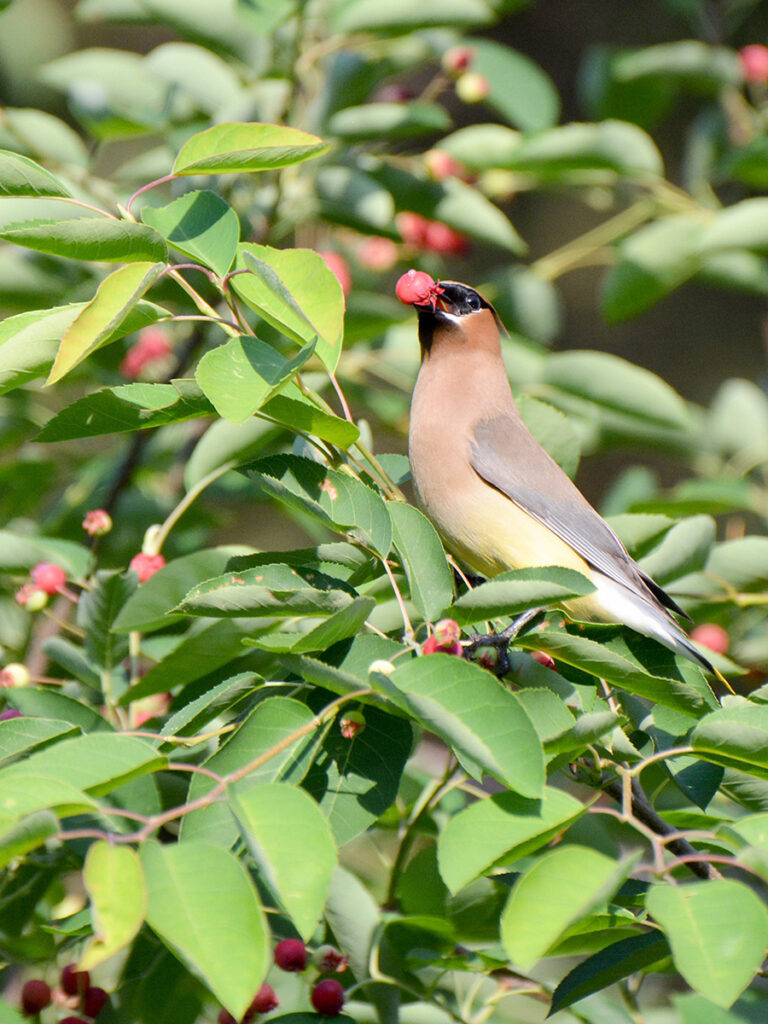
Over the years, we’ve added many native shrubs and trees, such as this serviceberry, that produce nutritious berries throughout the year from serviceberries in the spring to winterberries in the winter.
By planting a variety of native trees and shrubs, we have some form of fruit available throughout the year.
Besides berries, shrubs’ flowers are good sources of nectar and pollen, and the shrubs themselves provide cover.
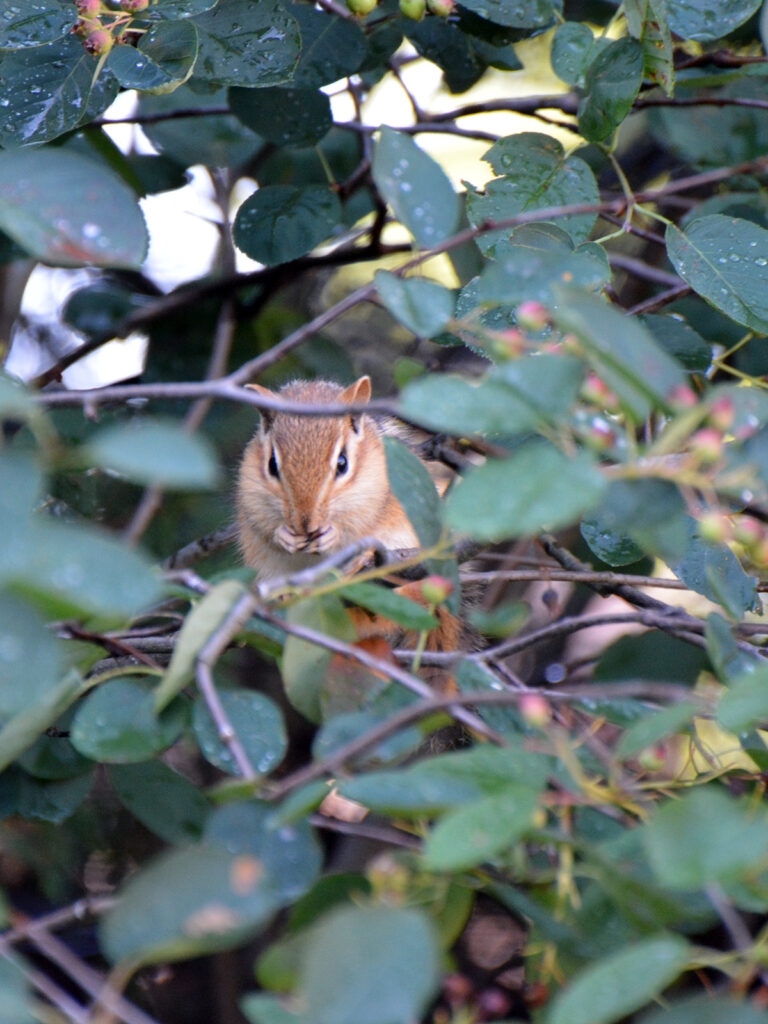
We primarily plant berries for the birds, but chipmunks and squirrels like them, too.
It’s annoying, though, to see them eating the berries before they even have a chance to ripen.
Fruit in spring
Bayberries (Myrica pensylvanica Syn. Morella pensylvanica)
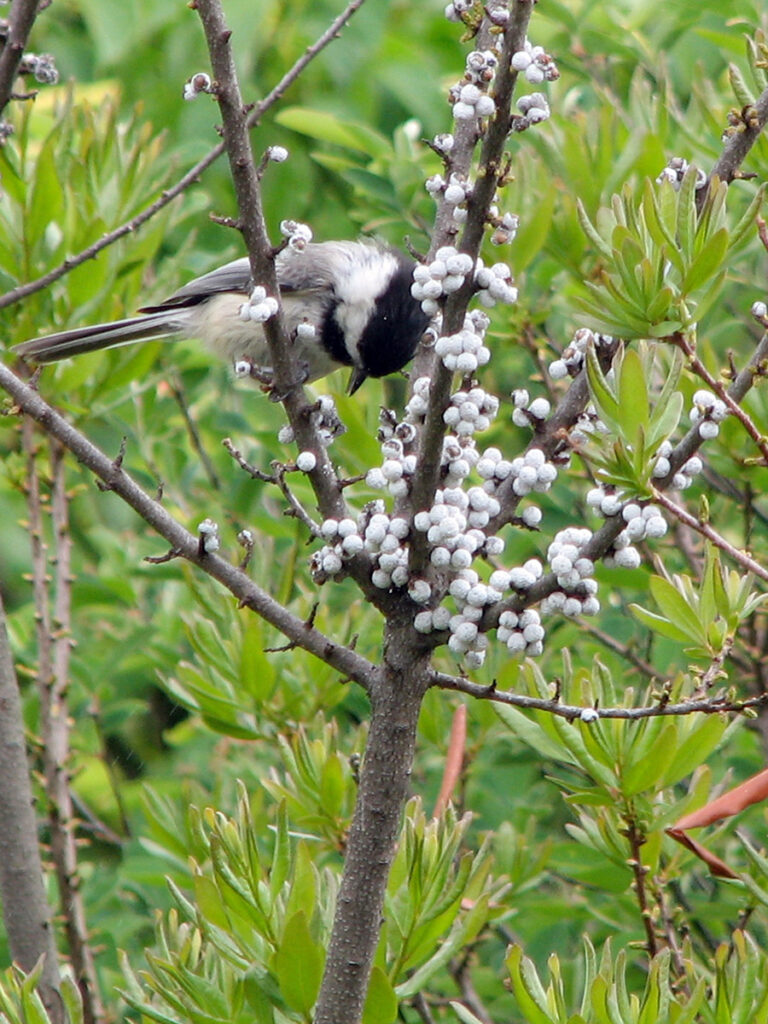
Much of the fruit in early spring is actually fruit produced the previous year that stayed through the winter.
These bayberries, for example, are produced the previous summer, and any not eaten in winter last all through the following spring.
Bayberries (NOT BARberries!) are a favorite of two of my favorite birds: chickadees and catbirds.
I’ve read that they’re more than half fat, which is why they’re important to fuel birds’ migration and as a way to make it through the cold winter months.
Of course, this high fat content is why the colonists used them to make candles! I think most modern bayberry candles are merely scented with bayberry, not made from them.
Winterberries (Ilex verticillata)
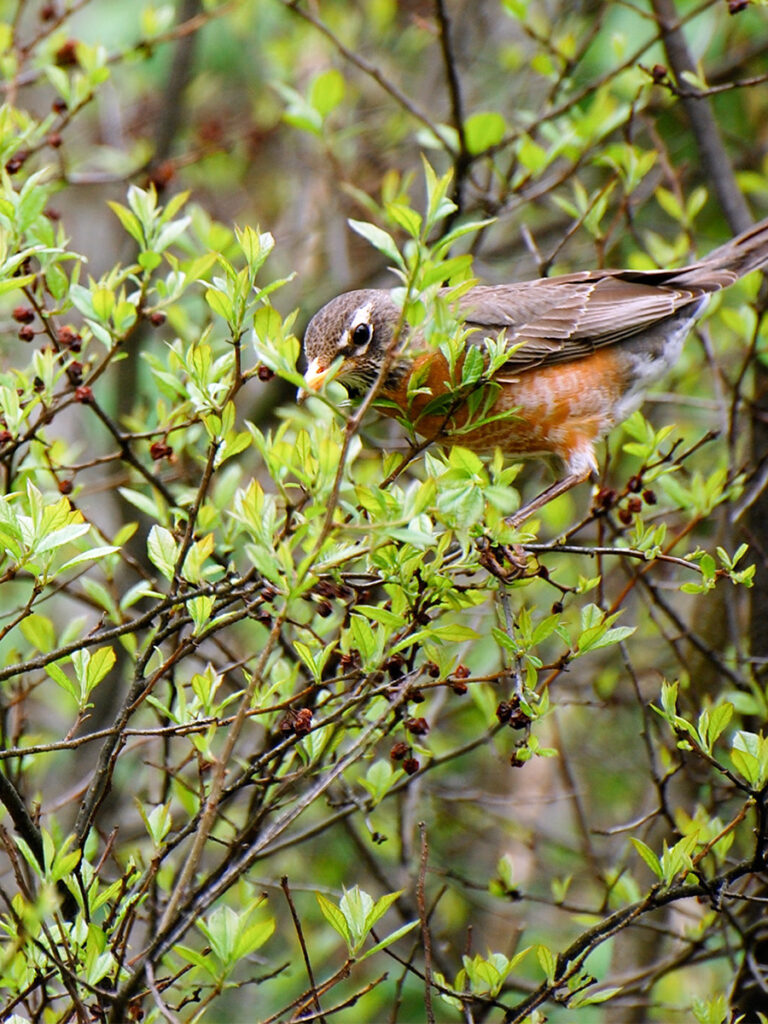
I don’t know if this was one of the robins that stayed all winter or a new arrival, but he was glad there were still some wizened-up winterberries left on the bush in early May.
Late winter and early spring can be a difficult time to find food, so they eat what they can find.
Fruit in summer
Serviceberries (Amelanchier spp.)
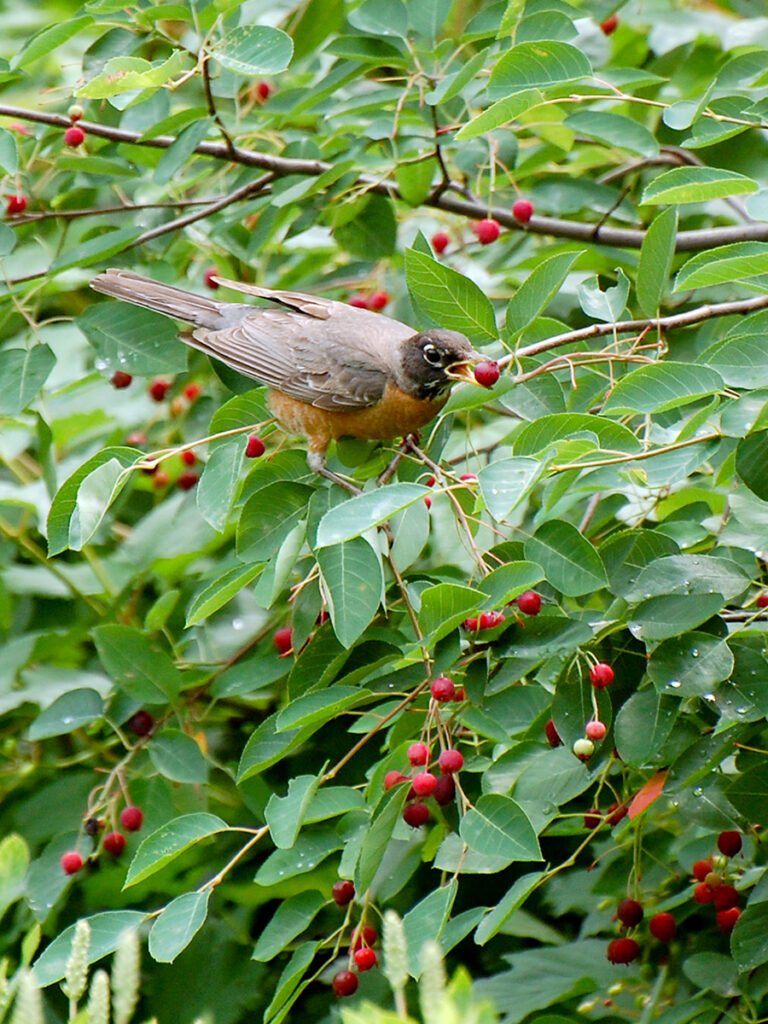
Serviceberries and pagoda dogwood berries are on the menu in summer. Catbirds and robins are especially fond of these berries, but other birds like them, too. Serviceberries (Amelanchier), also known as Juneberries, are the first summer fruits that develop in our yard.
We grow a number of Amelanchier species: shadblow (A. canadensis), Allegheny (A. laevis), and the apple serviceberry (A. x grandiflora), a naturally-occurring hybrid of A. laevis and A. arborea.
Pagoda dogwood (Cornus alternifolia)
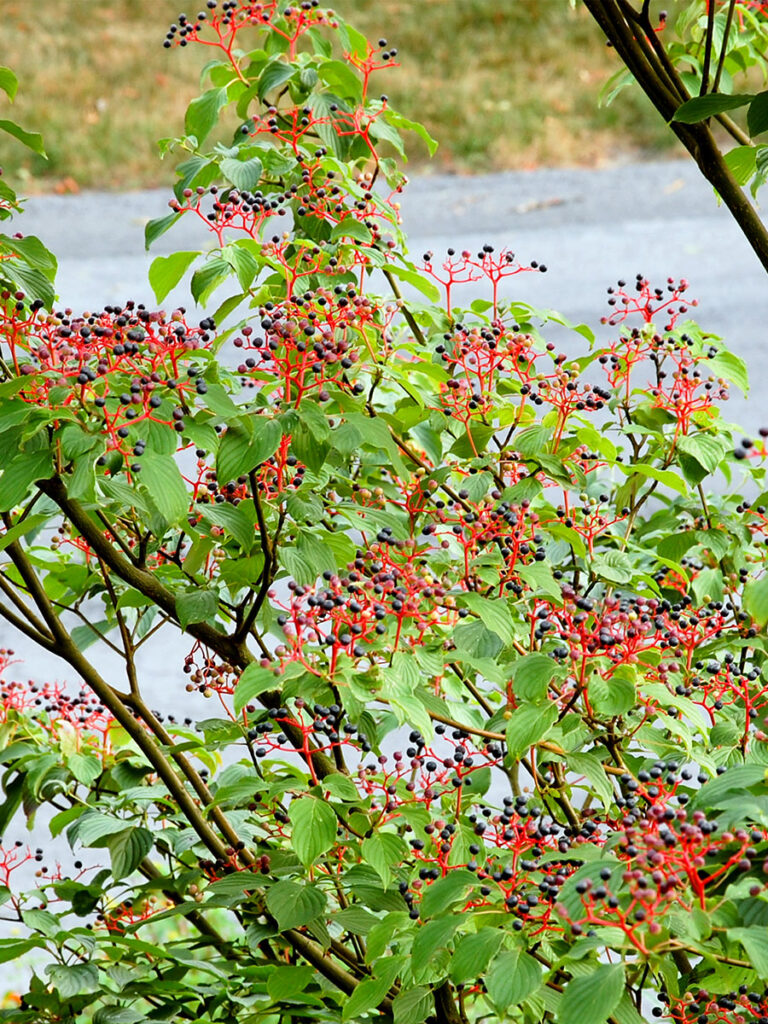
We love pagoda dogwood. It’s puzzling that so few people grow it. Being an understory plants, it grows well in sun to partial shade.
It has a beautiful horizontal branching structure (the reason for its Asian-sounding name), nectar-rich flowers in the spring, and beautiful dark, nutritious, blue berries birds love.
Blueberries
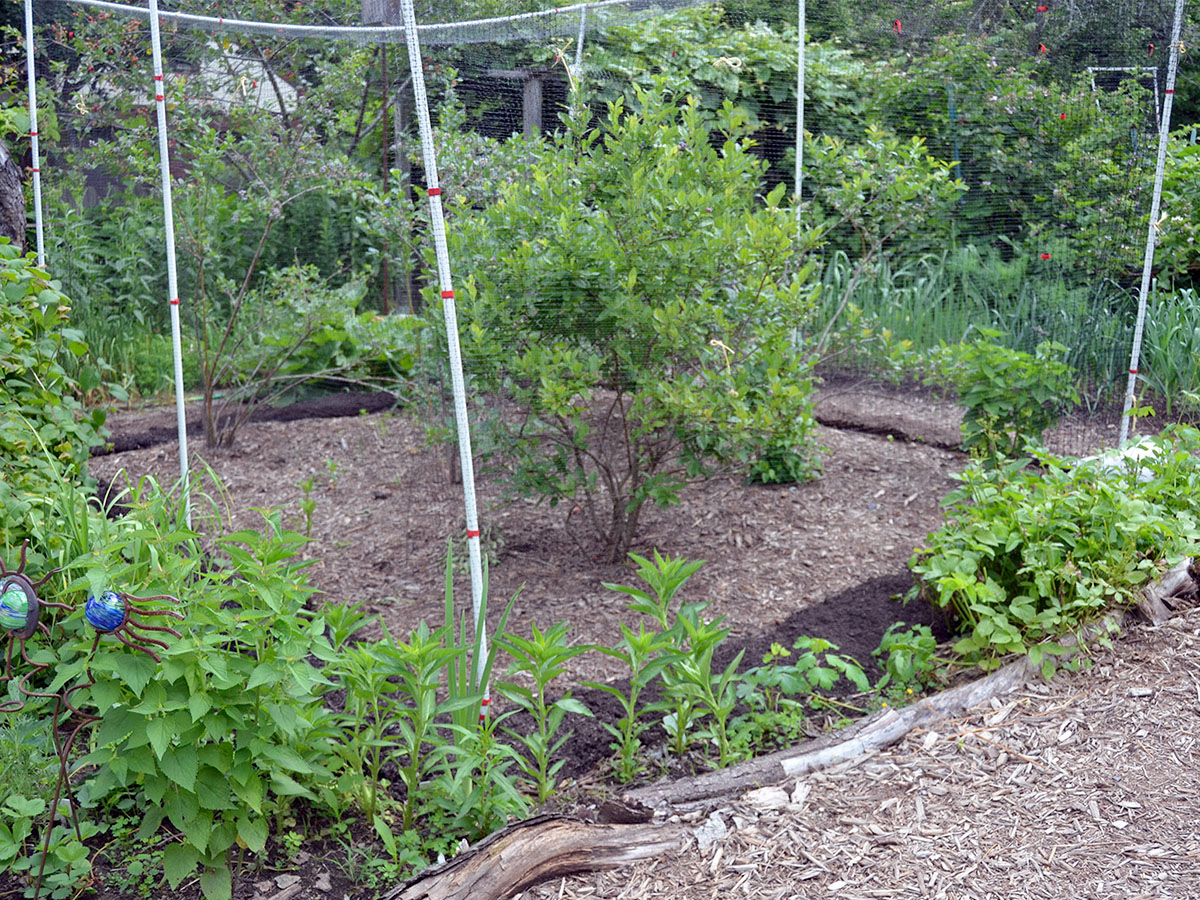
Theoretically blueberries are a good plant for birds, but these blueberries are in our edible garden, so they’re for us. Each year we create this structure, cover it with bird netting, and stake it down at the bottom as securely as we can. We have it up for only about a month during harvest. It works pretty well, though each year a few birds are bright enough to find their way in, but not bright enough to find their way out. We keep a close watch on it so we can rescue any birds that get in.
We do have a few blueberry bushes outside the netting, and although they weren’t initially intended as bird food, we’ve given up on them and just let the birds eat them.
And we have a great crop of blueberries since we have a willing crew of pollinators in the yard! Blueberries are a great source of nectar and pollen in spring, and we love to watch the bumble bees at work, helping make our food.
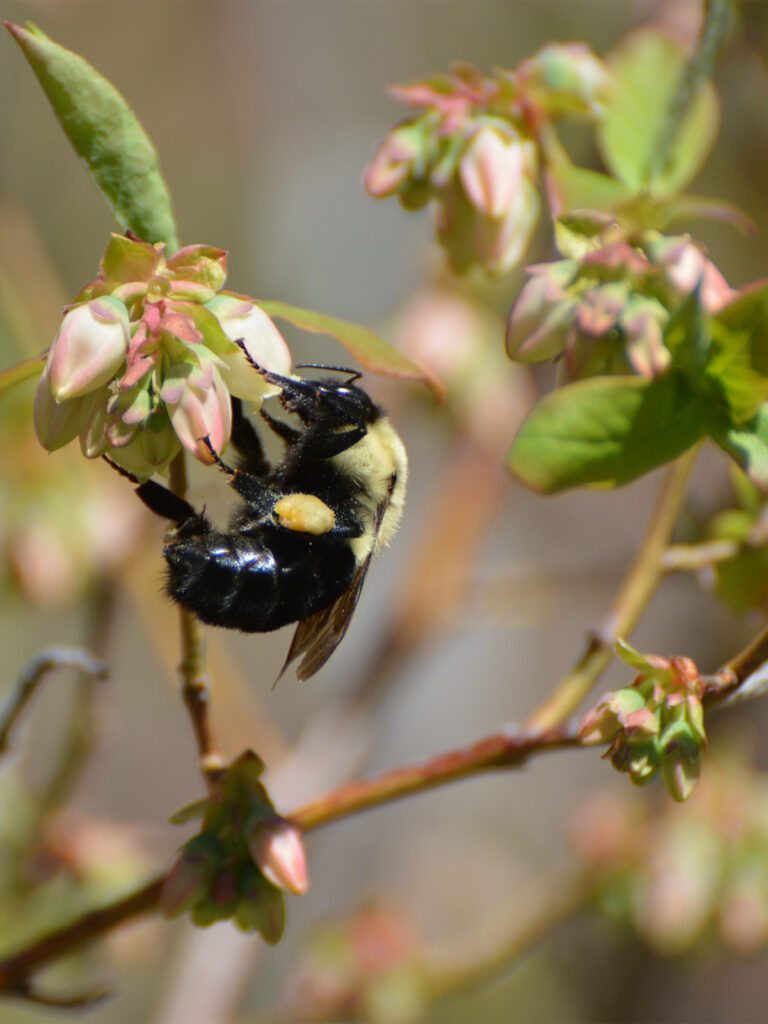
Fruit in fall
Gray dogwood (Cornus racemosa)
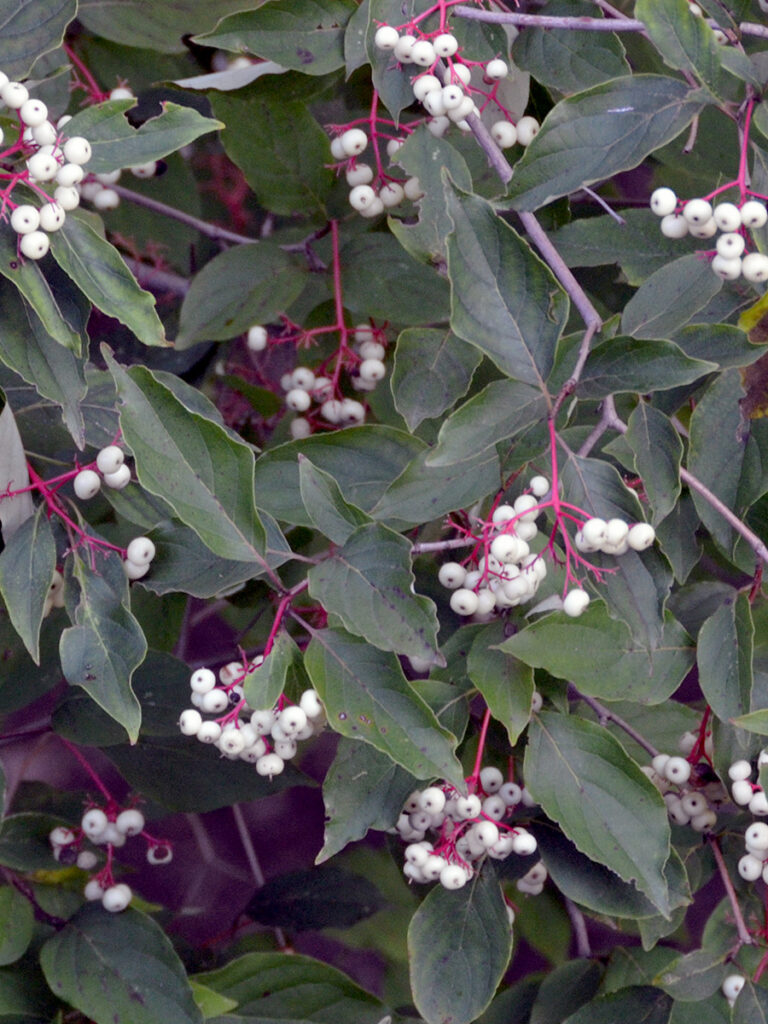
Dogwoods are a large and wonderful group of plants, valuable for many creatures, but especially for birds. I have quite a few varieties — some understory trees, some shrubs.
Most of these dogwoods (except for the pagoda dogwood above) fruit in the fall. Dogwood shrubs are generally about 6-10 feet tall, and also provide nectar and cover.
Silky dogwood (Cornus amomum)
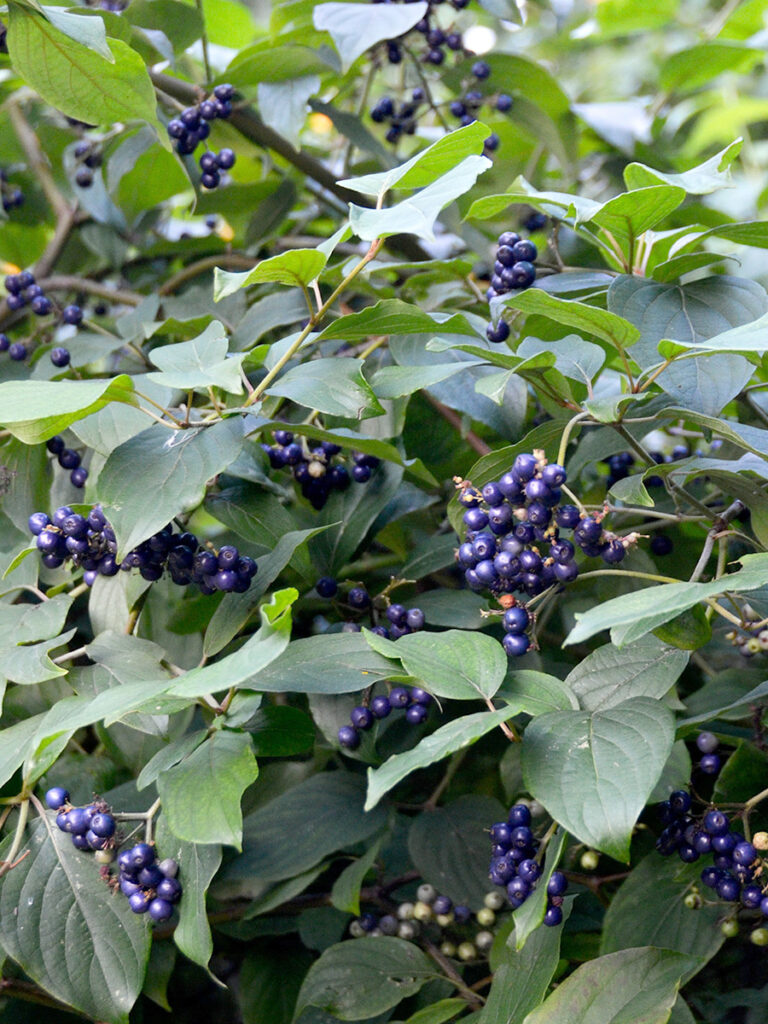
The silky dogwood berries conveniently ripen after the gray dogwood berries, further extending the berry season.
And they also have a beautiful color, different from the pagoda dogwood or the gray dogwood.
BUT NOT Kousa dogwood (Cornus kousa)
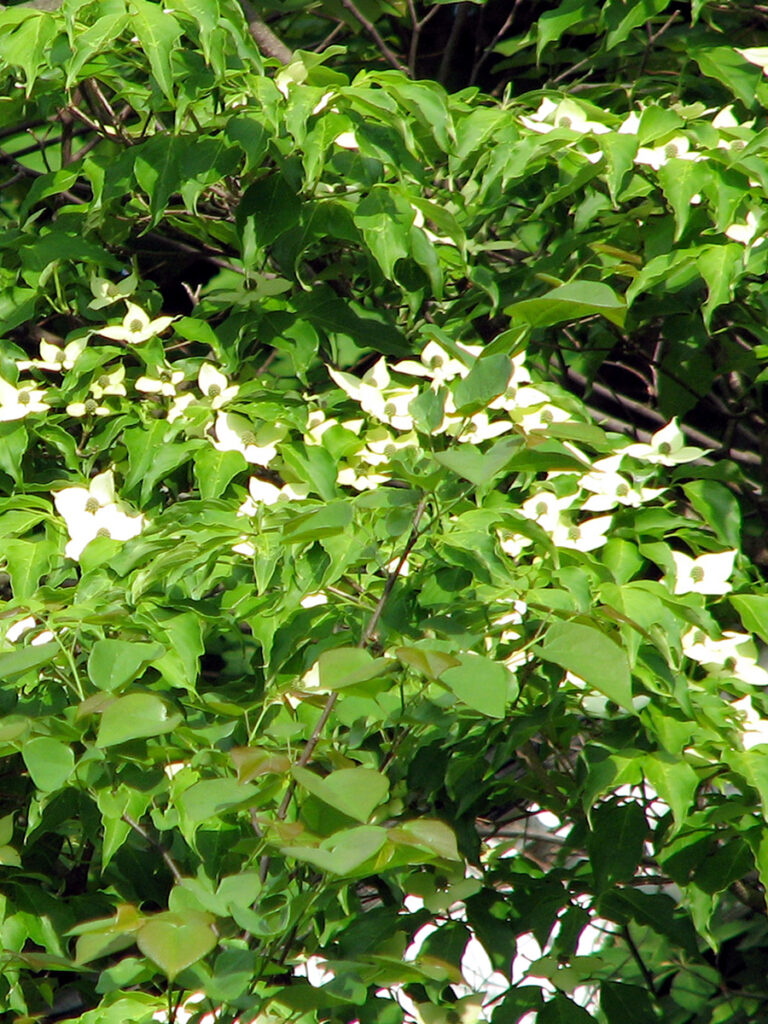
One kind of dogwood we do NOT want is the non-native Kousa dogwood (Cornus kousa).
It offers nothing for wildlife even as in millions of home and community landscapes it’s replacing the native dogwoods that are so important to wildlife.
Even worse, some experts believe that the Kousa may be the source of the anthracnose that has made our native flowering dogwoods problematic!

Unfortunately, when we originally landscaped our property, we had hired a professional landscaper who planted a non-native invasive kousa dogwood (of course!). As it grew larger, we tried cutting limbs off each year, but this became not just difficult, but dangerous. We finally hired someone with a chainsaw to remove it, and this person said it was one of the hardest woods he had encountered. It did make some nice logs!
We’re glad it’s gone. (We also learned that we can’t do EVERYTHING ourselves…)
Viburnums
Native viburnums traditionally have been a valuable wildlife plant. Soon after we started gardening for habitat, we planted three arrowwood viburnums.
THEN the non-native viburnum leaf beetle arrived here in Central New York and devastated many viburnums, especially native varieties. Unfortunately, it turned out that arrowwood viburnum is one of its favorites!
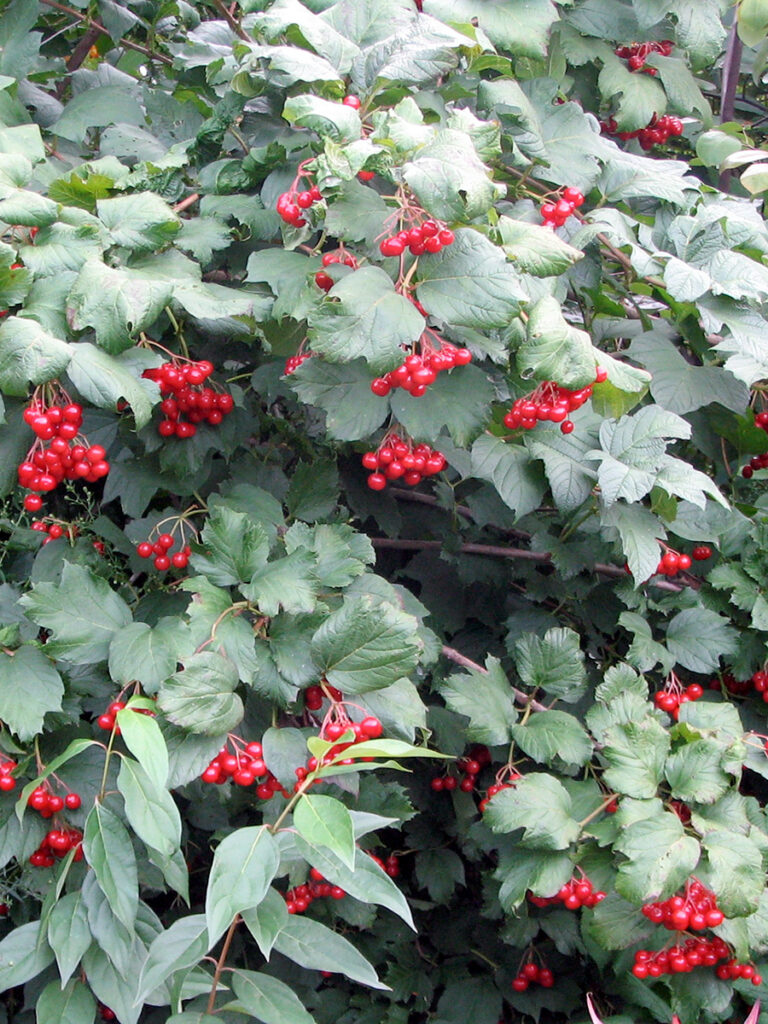
We also thought we had planted a highbush cranberry viburnum (not a real cranberry), and just as it was recovering from the leaf beetle, we determined that it was instead probably the non-native variety.
The European variety is Viburnum opulus and the native variety is Viburnum opulus var. americanum. This plant is often misidentified on the label as the American highbush cranberry, so it’s worth checking carefully before planting! We later removed the plant.
Fruit in winter
Our bayberries (described above), winterberries, and junipers/cedars provide fruit for birds in winter.
Of course, winterberries provide food in winter, not just in spring (as described above).
The mockingbird claimed this bush for a few years, and the robin had to find the right time to sneak in for a few berries.
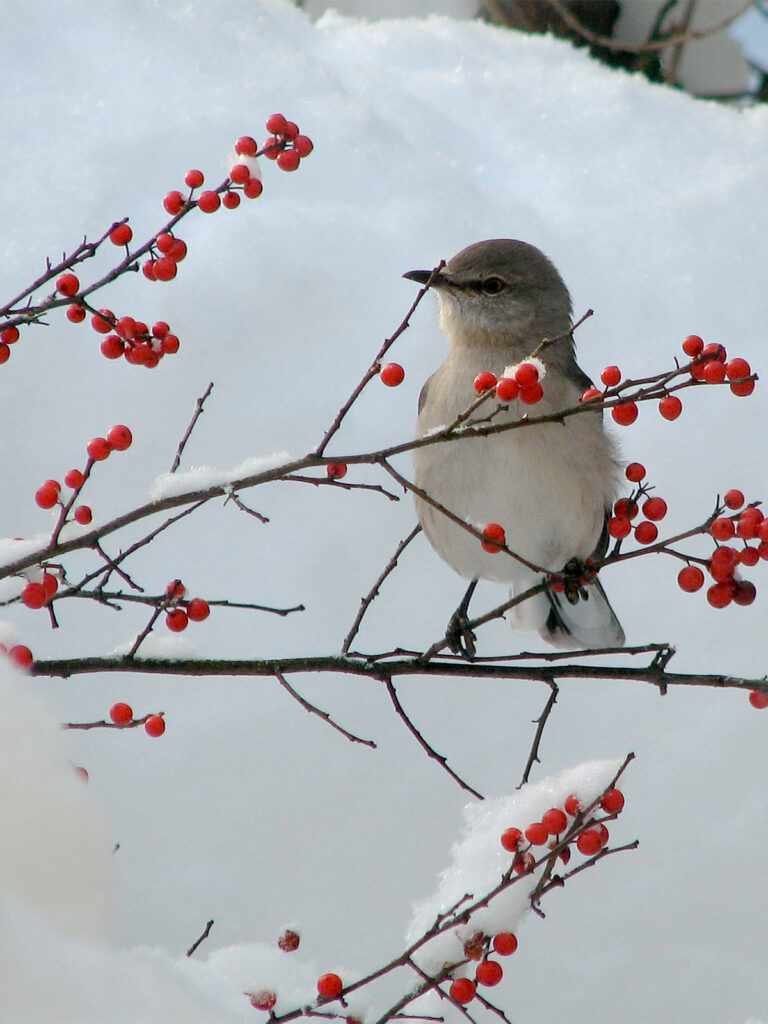
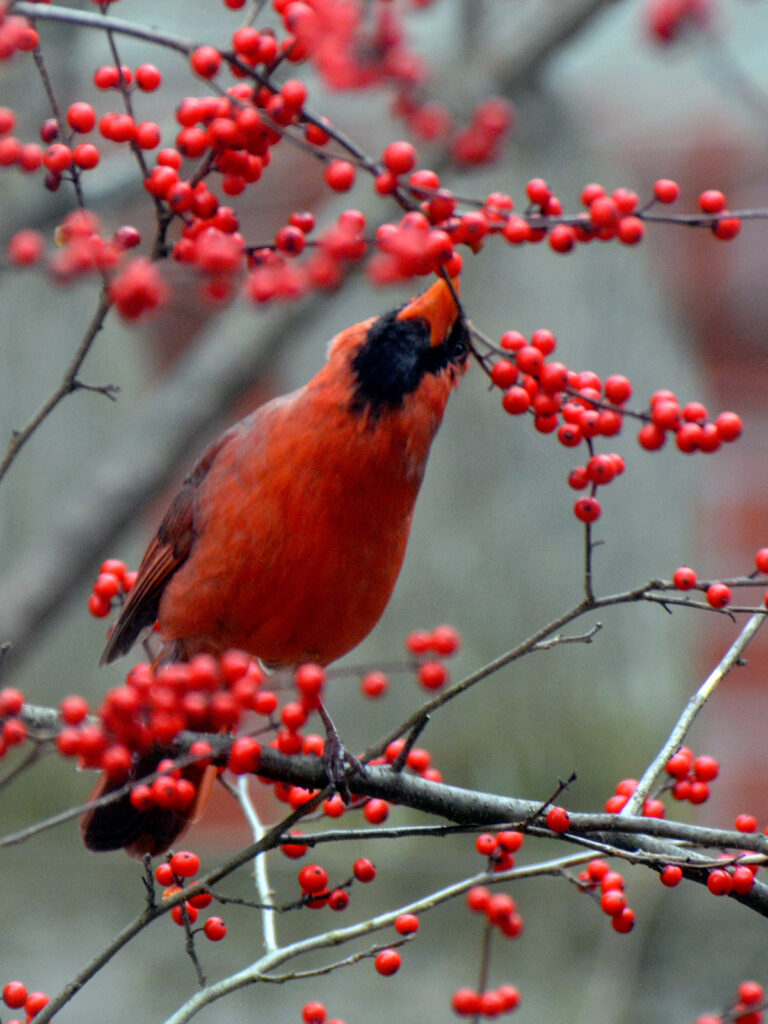
Cardinals like them, too.
Red cedar (Juniperus virginiana)
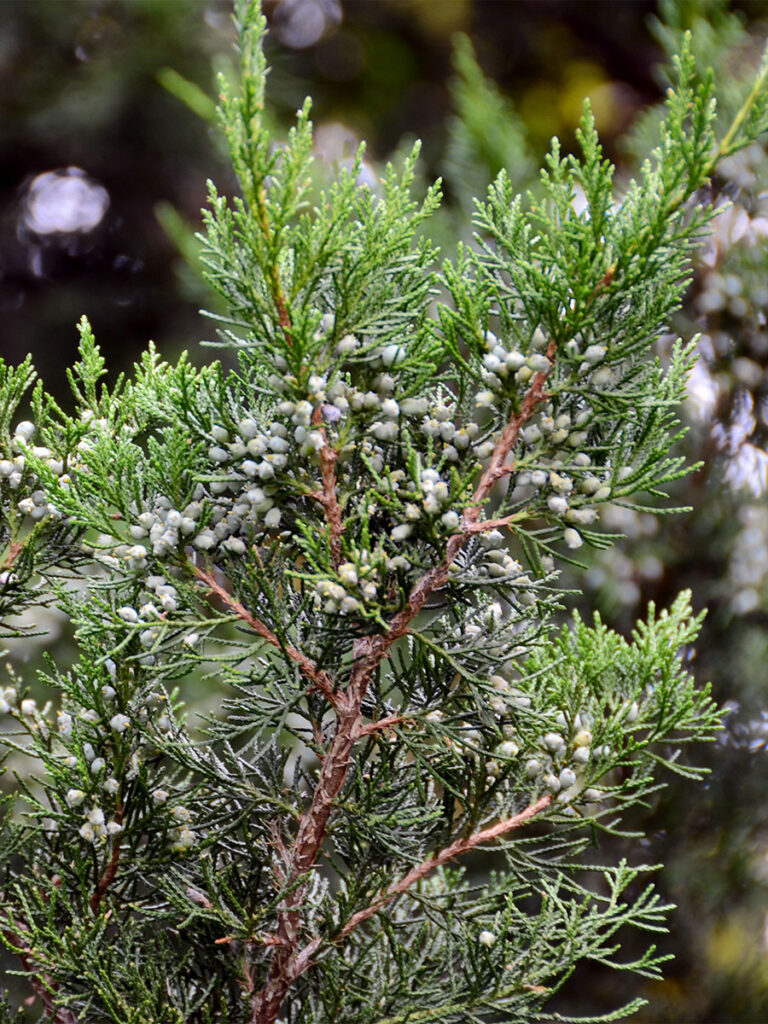
The red cedar, as the name suggests, is a favorite of cedar waxwings.
(Factoid: These berries are the important ingredient in gin!)
Resources
- Cornell:
- Viburnum Leaf Beetle Citizen Science home page has videos showing adults laying eggs, larva emerging, larva feeding, and adults feeding.
- Univ. of Maine:
- Highbush cranberry – Tips in the FAQs for distinguishing between the European and the native.
Reflections
Amelanchier plants are fruiting machines! Unlike most wild fruits, the blueberry-shaped Amelanchier fruit is fully ripe in mid June to early July (the fruit goes from green to red to purple). For birds this timing is important because few other plants provide such a bountiful and easily harvested food supply at this time of year.
~ Joel Baines, Native Plants for Native Birds
Plants that bear fruit in the summer generally dole their berries out as though by prior agreement, sharing the planting season so that each gets its turn and customers are fed from June through August. Each speaks to the locals who have time to learn where and when to find it. Raspberries, like strawberries, waft a fragrance. Blueberries and serviceberries speak in three colors. Green fruits are toxic and not yet nourishing. A rosy blush signals impending ripeness (resident animals monitor blushing berries like children watch cookies browning in the oven). The blue ones say “Eat me” very clearly. We don’t have to attend to these details. It’s like buying groceries once and watching meals prepare themselves for years.
~ Sara Stein, Noah’s Garden, 1993, pp. 64-65
Let’s imagine a goal: that at some time in the future, the value of a property will be perceived in part according to its value to wildlife. A property hedged with fruiting shrubs will be worth more than one bordered by forsythia. One with dry-stone walls that provide passageways for chipmunks will be valued higher than one whose walls are cemented stone. Buyers will place a premium on lots that provide summer flowers and fall crops of seed. …
Oh, brave new world!
~ Sara Stein, Noah’s Garden, p. 244
Invasion of viburnum leaf beetle has direct adverse effects on arrowwood, reducing flower and fruit production and gradually leading to death of attacked shrubs. Loss of fruit production may have a serious negative im pact on both migrant and resident songbirds, as well as small mammals; other researchers have shown that reduced fruit availability in stopover locations has been directly linked to reduced songbird abundance in both stopover and overwintering habitats. Thus, viburnum leaf beetle directly threatens arrowwood viburnum and may indirectly threaten migratory songbird survival.
~ Paul A. Weston and Victoria Nuzzo, The Impact of Viburnum Leaf Beetle on Native Arrowwood (a PDF file)
